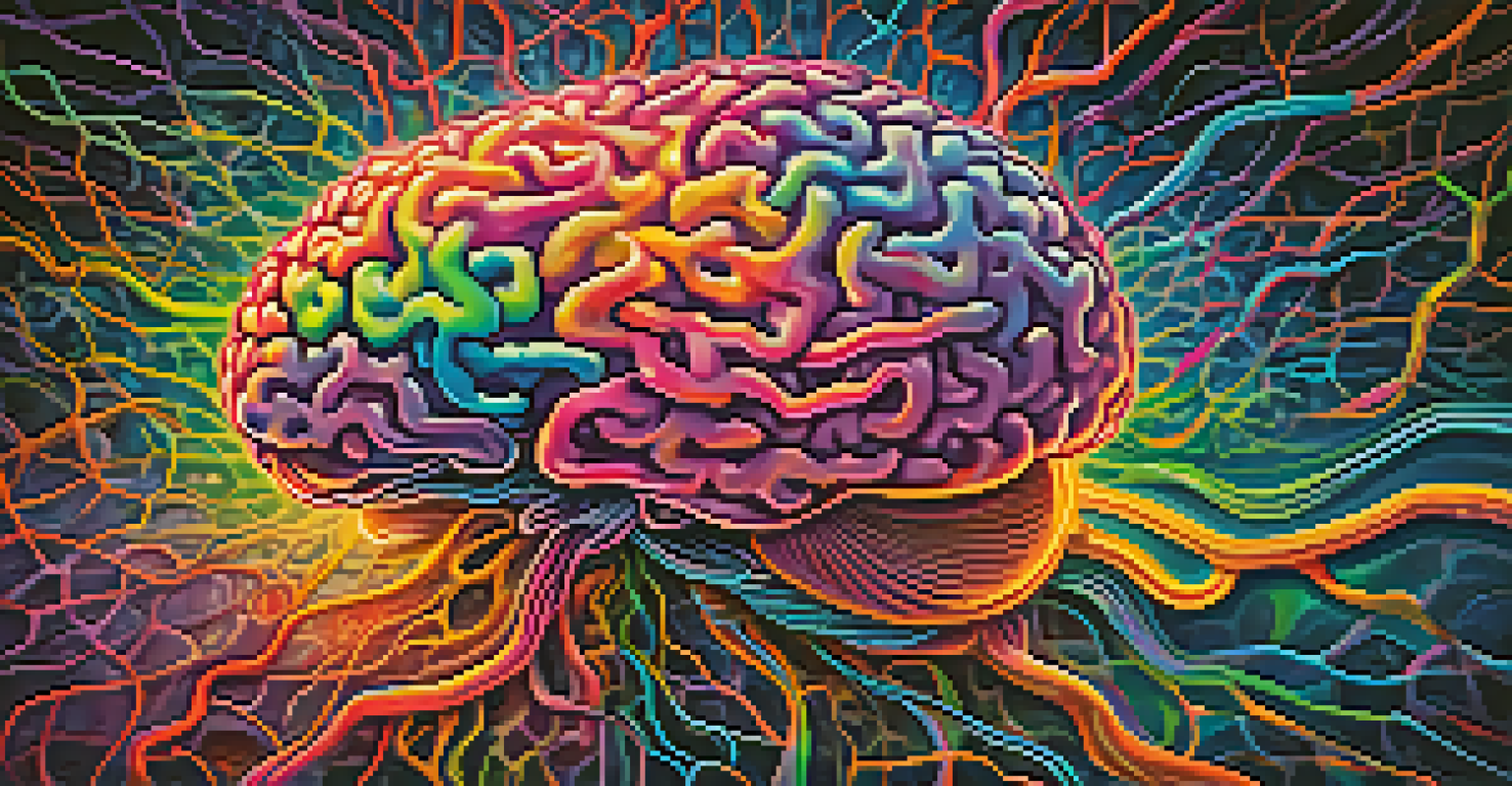Ayahuasca and Neurochemistry: What Science Reveals

Understanding Ayahuasca: A Brief Overview
Ayahuasca is a traditional Amazonian brew made from the Banisteriopsis caapi vine and other plant ingredients. It's been used for centuries in indigenous cultures for spiritual and healing purposes. The brew is known for its psychoactive effects, primarily due to the presence of the compound DMT (dimethyltryptamine). Understanding Ayahuasca involves delving into its complex blend of ingredients and the cultural significance behind its use.
The experience of Ayahuasca is often described as a journey into the self, revealing layers of consciousness that can lead to profound personal insights.
In recent years, Ayahuasca has gained popularity outside of its traditional context, particularly in the realms of mental health and personal development. Many individuals seek it out for experiences of deep introspection, emotional healing, and spiritual growth. The growing interest has prompted scientific inquiry into how Ayahuasca impacts the brain and body, shedding light on its potential therapeutic effects.
As we explore Ayahuasca's effects on neurochemistry, it's crucial to recognize the interplay between its historical roots and modern scientific research. This unique combination of ancient wisdom and contemporary science may provide valuable insights into the brew's benefits and risks.
The Role of DMT in Ayahuasca Experience
DMT, a potent psychedelic compound, is central to the Ayahuasca experience. When consumed, it interacts with serotonin receptors in the brain, leading to altered states of consciousness. This interaction can induce vivid visual hallucinations, profound emotional experiences, and a sense of connection to something greater than oneself. For many, these effects are at the core of why they seek out Ayahuasca ceremonies.

Research shows that DMT can also promote neuroplasticity, the brain's ability to reorganize itself by forming new neural connections. This flexibility is crucial for learning, memory, and recovery from trauma. By facilitating neuroplasticity, DMT may help individuals process and integrate their experiences more effectively, potentially leading to lasting changes in mental health.
Ayahuasca's Cultural Significance
Ayahuasca has deep roots in indigenous cultures, used for spiritual and healing purposes for centuries.
However, it's important to note that the effects of DMT can vary widely among individuals. Factors such as set (mindset) and setting (environment) play a significant role in shaping the experience. Understanding these variables is crucial for those considering Ayahuasca as a therapeutic option.
The Impact of Ayahuasca on Neurotransmitters
Neurotransmitters are essential chemical messengers that transmit signals in the brain, influencing mood, perception, and cognition. Ayahuasca has been shown to affect several neurotransmitter systems, particularly serotonin, dopamine, and norepinephrine. These changes can lead to shifts in mood, increased emotional awareness, and altered perceptions of reality.
Ayahuasca allows us to explore the inner workings of our minds, offering a chance for healing and transformation.
For instance, the serotonin system plays a significant role in regulating mood and emotional responses. By modulating serotonin levels, Ayahuasca may help alleviate symptoms of depression and anxiety for some individuals. Similarly, the influence on dopamine, which is linked to pleasure and reward, can enhance feelings of well-being and satisfaction during the experience.
However, the relationship between Ayahuasca and neurotransmitters is complex and not fully understood. Individual responses can vary, and while some may find relief from mental health issues, others may experience challenging emotions or insights during their journey.
Ayahuasca and the Brain: What Imaging Reveals
Recent studies utilizing brain imaging techniques, such as fMRI (functional Magnetic Resonance Imaging), have provided valuable insights into how Ayahuasca affects brain function. These studies have revealed changes in brain activity patterns during Ayahuasca experiences, particularly in areas related to consciousness, emotional processing, and self-referential thinking. This suggests a shift in how individuals perceive themselves and their emotions while under the influence of the brew.
One notable finding is the increased connectivity between different brain regions, which may explain the feelings of unity and interconnectedness reported by many participants. This enhanced communication between areas of the brain could facilitate deep introspective insights and emotional healing. Such findings underscore the potential of Ayahuasca as a tool for self-discovery and personal growth.
DMT's Impact on Mental Health
DMT, a key compound in Ayahuasca, can promote neuroplasticity and alter consciousness, potentially aiding mental health.
However, it's essential to approach these findings with caution. While brain imaging can shed light on the effects of Ayahuasca, individual experiences can be highly variable. Further research is needed to fully understand the implications of these changes and how they translate to real-world outcomes.
Therapeutic Potential: Mental Health and Ayahuasca
The growing interest in Ayahuasca as a therapeutic tool has led to investigations into its potential benefits for mental health. Preliminary studies suggest that Ayahuasca may help alleviate symptoms of depression, anxiety, PTSD, and addiction. Many users report profound emotional releases and insights that contribute to their healing journeys, making it a compelling area for further exploration.
One of the key aspects of Ayahuasca therapy is the guided experience, often facilitated by a shaman or experienced practitioner. This supportive environment can help individuals navigate their emotions and insights safely. The combination of the brew's effects and the therapeutic setting may enhance the overall experience, allowing for deeper healing and integration.
However, it's important to note that Ayahuasca is not a panacea. While many find relief, others may not experience the same benefits or may confront difficult emotions during their journey. Mental health interventions should be personalized, and Ayahuasca should be approached with careful consideration and respect.
Risks and Considerations of Ayahuasca Use
While Ayahuasca has garnered attention for its potential benefits, it's crucial to acknowledge the risks associated with its use. Adverse reactions can range from nausea and vomiting to psychological distress, especially for individuals with pre-existing mental health conditions. Understanding these risks is essential for anyone considering participating in an Ayahuasca ceremony.
Furthermore, the legal status of Ayahuasca varies by country, and it's important to be aware of the regulations surrounding its use. In some places, it may be legal in ceremonial contexts, while in others, it remains prohibited. Navigating these legal landscapes is a vital part of ensuring a safe and responsible experience.
Risks of Ayahuasca Use
While Ayahuasca offers therapeutic potential, it also carries risks, including adverse physical and psychological reactions.
Lastly, finding reputable and ethical practitioners is paramount. The rise in popularity has led to an increase in unregulated ceremonies, which can pose significant risks. Ensuring that one participates in a safe and supportive environment can help mitigate potential dangers associated with Ayahuasca use.
The Future of Ayahuasca Research and Understanding
As interest in Ayahuasca continues to grow, so does the need for rigorous scientific research. Exploring its neurochemical effects, therapeutic potential, and associated risks can help demystify the brew and inform safe practices. Future studies may provide deeper insights into how Ayahuasca can be integrated into mental health treatment and personal growth modalities.
Additionally, as more individuals share their experiences with Ayahuasca, it contributes to a broader understanding of its effects on various populations. This anecdotal evidence, combined with scientific research, can paint a more comprehensive picture of the brew's potential benefits and limitations.

Ultimately, the future of Ayahuasca research holds promise not just for individual healing but also for a deeper understanding of consciousness and the human experience. As we continue to learn from both ancient traditions and modern science, we can foster a greater appreciation for the complexities of the mind and the power of nature.